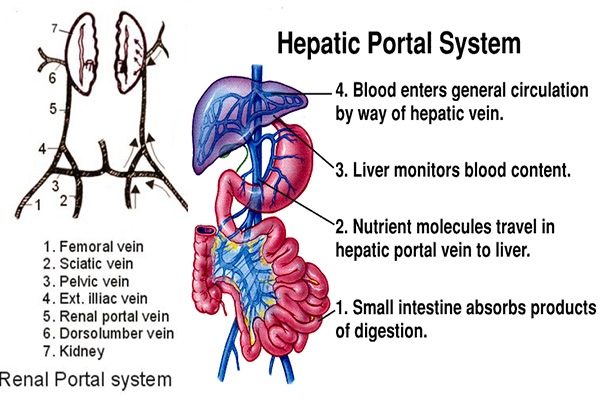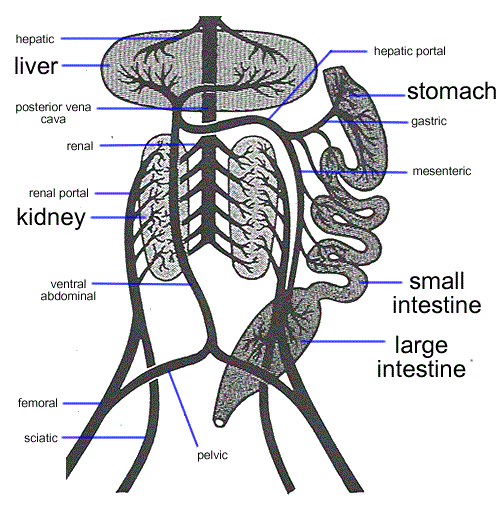Portal System of Frog
Portal System of Frog
The portal system is defined as a system of blood vessels in which veins carrying blood from different parts of the body is first broken up into capillaries in another organ like kidney or liver then the blood is collected by another set of capillaries which unite to form another vein that carries blood to the heart.
Portal vein is therefore originates from capillaries and terminates as capillaries. Thus it is also called double capillaries system.
Generally veins collect blood from different parts of the body and bring it to the heart. However, there are some veins which before reaching the heart take the blood to some other organs where they form network of capillaries. These veins are called portal veins.
The organs which receive blood from portal veins are called portal organ.
There are two portal system in frogs:
1. Renal Portal System
The veins which carry blood to capillary system in kidneys constitute the renal portal system. It collects blood from all parts of the hind limbs. The impure blood is collected by capillaries, which combine to form femoral and sciatic vein. The femoral vein runs on the outer side and sciatic veins on inner side of each leg. The femoral vein on entering the body cavity divides into dorsal (external iliac vein) and ventral (inner pelvic vein) branches. The dorsal femoral branch joins with sciatic vein in coelom and forms renal portal vein. The renal portal vein runs outside to the kidneys and receives blood from dorso-lumbar vein and enters the kidney by number of branches from outer margin.
Inside the kidney these veins break and rebreak to form capillaries. These capillaries form 5 to 6 renal veins on emerging from the kidneys and open into post caval vein. All these veins forms renal portal system.
The renal veins of both sides, along with gonadial veins from gonads, join to form large median vein called postcaval vein. The postcaval runs upward, passed through liver and opens into sinus venosus.
The impure blood from the posterior part of the body passes through the tissues of the kidney, on its way to post caval by this portal system.
Importance of Renal Portal System
The different parts of the body are supplied with mixed blood and this blood returns to the kidneys, it becomes more impure containing harmful substances such as urea carbon dioxide and other nitrogenous wastes. The harmful substances are separated from the blood by kidneys and are passed outside in the form of urine.
2. Hepatic Portal System
It consists of the veins collecting the blood from alimentary canal and hind limbs and distributing blood to the liver.
It consists of:
i. Anterior abdominal vein- It is a median vein and formed by the union of two pelvic vein and vesicular vein.
Pelvic veins are the lateral branches of femoral veins from hind limbs which collect blood from the outer parts of the hind limbs. Vesicular vein collects blood from the urinary bladder.
The anterior abdominal vein runs forward along the mid-ventral line of the body wall, towards the liver. At the anterior most end, it divides into two branches entering the right and left lobes of the liver where it breaks up into capillaries inside it. It also gives a short branch which joins the hepatic portal vein before entering the liver.
ii. Hepatic portal vein- It is a large vein, which collects blood from different parts of the alimentary canal and the spleen. It is formed by the union of following veins:
- Gastric vein- It collects blood from the stomach
- Duodeno-pancreatic vein- collects blood from duodenum and pancreas.
- Intestinal vein- collects blood from intestine.
- Splenic vein- collects blood from the spleen.
- Rectal vein- collects blood from the rectum.
Significance of Hepatic Portal System
The blood from alimentary canal contains excess glucose, amino acids etc. which is absorbed by liver.
Ammonia and amino acids are converted into urea and uric acids.



good job i was searching it from long period …and hope that ur info will be use ful at degree level .thank u
nice notes they have helped me
Great Information , it will be helpful for my daughter